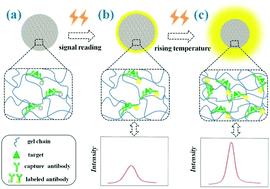Responsive photonic barcodes for sensitive multiplex bioassay†
Abstract
Barcodes have a demonstrated value for multiplex high-throughput bioassays. The tendency of this technology is to pursue high sensitivity target screening. Herein, we presented a new type of inverse opal-structured poly(N-isopropylacrylamide) (pNIPAM) hydrogel photonic crystal (PhC) barcodes with the function of fluorescent signal self-amplification for the detection. During the bio-reaction process at body temperature, the pNIPAM hydrogel barcodes kept swelling, and their inverse opal structure with interconnected pores provided unblocked channels for the targets to diffuse into the voids of the barcodes and react. During the detection process, the barcodes were kept at a volume phase transition temperature (VPTT) to shrink their volume; this resulted in an obvious increase in the density of fluorescent molecules and signal amplification. It was demonstrated that the responsive barcodes could achieve the limits of detection (LOD) of α-fetoprotein (AFP) and carcinoembryonic antigen (CEA) at 0.623 ng mL−1 and 0.492 ng mL−1, respectively. In addition, the proposed barcodes showed good multiplex detection capacity with acceptable cross-reactivity, accuracy, and reproducibility, and the results were consistent with those of common clinical laboratory methods for the detection of clinical samples. These features of the inverse opal-structured responsive hydrogel barcodes indicate that they are ideal technology for high-sensitive multiplex bioassays.



 Please wait while we load your content...
Please wait while we load your content...